#doordash clone app
Text
How DoorDash Strategy Made It America’s Top Food Delivery Service
DoorDash has emerged as the leading food delivery service in the United States. This prestigious company has outpaced its competitors and dominates the market with its innovative strategies and commitment to customer satisfaction. This blog explores the key elements of DoorDash's strategy that have contributed to its success by focusing on its market approach, technological innovations, and strategic partnerships.
Market Approach
The rise in popularity of DoorDash can be linked to its clever market strategy and aggressive expansion efforts. When this business was first established in 2013, it focused on local markets before gradually expanding to cover broader regions. Another vital aspect of its strategy was identifying and targeting underserved markets. DoorDash quickly made a name for itself by entering areas and cities with limited food delivery options.
Another way the business set itself apart was by providing a wide selection of delivery choices. Unlike many of its rivals, DoorDash has expanded its offerings to include convenience stores, groceries, and alcoholic beverages in addition to restaurants. Besides attracting more clients, this diversification enabled DoorDash to establish itself as a one-stop shop for all delivery needs.
Technological Breakthroughs
Technology has played a pivotal role in DoorDash’s success. The company has invested heavily in developing and refining its platform to enhance customer and delivery partner user experiences. One standout feature of DoorDash's technology is its cultured algorithms for facilitating delivery routes, thus saving delivery times. DoorDash ensures the fulfillment of orders by using real-time data and machine learning.
Another significant innovation is the DoorDash Drive program, which allows businesses to use delivery infrastructure for their delivery needs. This program increases revenue streams and strengthens relationships with partner businesses. The company integrates advanced research to provide insights into customer preferences and behavior, enabling more targeted marketing and promotions.
Strategic Collaboration And Advertising
Strategic partnerships have been a cornerstone of DoorDash’s growth strategy. The firm has formed alliances with major restaurant chains, grocery stores, and even alcohol retailers to expand its reach and service offerings. These partnerships not only increase the variety of products available to customers but also enhance the market's credibility and appeal.
Marketing has also been a crucial component of DoorDash’s strategy. It has employed a mix of traditional and digital marketing techniques to build brand awareness and attract new users. Also, high-profile advertising campaigns, sponsorships, and promotions have helped DoorDash stand out in a crowded market.
To summarize
DoorDash’s rise to the top of America’s food delivery industry is due to its strategic market approach, technological innovations, and effective partnerships and marketing. Therefore, if you are considering developing a clone app like DoorDash, SpotnEats is your ideal companion. Additionally, we have customized numerous apps, integrating features tailored to your business needs, enhancing revenue and consumer satisfaction.
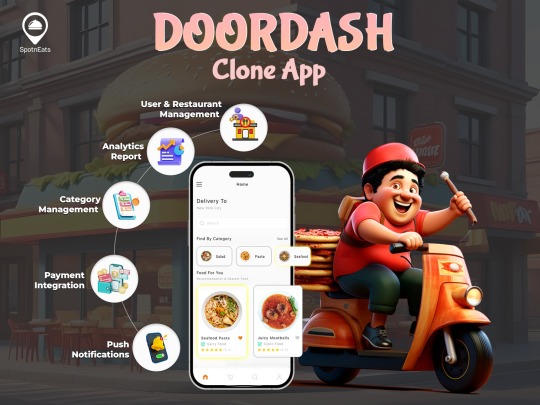
#food delivery app usa#food delivery script#doordash clone app#doordash clone#doordash food delivery app
0 notes
Text
Maximizing Your Restaurant's Revenue with a Doordash Clone Solution
As a restaurant owner, you are always looking for ways to increase revenue and attract new customers. One way to do this is by offering food delivery services through a platform like Doordash. However, investing in a Doordash clone solution can offer even more benefits for your restaurant.
Doordash clone overview
A Doordash clone is a type of app or website that offers the same functionality as Doordash, but is customized and branded for your restaurant. This means that you can offer delivery services to your customers without having to pay a commission to a third-party delivery platform.
Increase sales with the Doordash clone app
Here are five ways a Doordash clone app can help maximize your restaurant's revenue:
Increased visibility and reach: By offering delivery services through a Doordash clone, you can increase the visibility of your restaurant to a wider audience. Customers who may not have known about your restaurant before can now discover it through the app, leading to more orders and increased revenue.
Control over pricing and menu options: With a Doordash clone, you have complete control over the menu options and pricing that you offer to customers. This means that you can adjust prices based on demand, seasonality, or other factors to maximize profits.
Reduced commission fees: As mentioned earlier, one of the major benefits of using a Doordash clone is that you don't have to pay a commission to a third-party delivery platform. This can save your restaurant a significant amount of money, which can then be reinvested back into the business to drive growth and increase revenue.
Improved customer loyalty: By offering delivery services through your own branded app, you can create a more seamless and personalized experience for your customers. This can lead to increased customer loyalty and repeat business, which is crucial for any restaurant.
Greater control over the delivery process: With a Doordash clone, you have complete control over the delivery process. This means that you can set your own delivery fees, choose your own delivery drivers, and manage the entire process in-house. This can lead to a more efficient and reliable delivery service, which is essential for customer satisfaction and repeat business.
Final Word
In summary, a Doordash clone solution can be a great way to maximize your restaurant's revenue by increasing visibility, controlling pricing and menu options, reducing commission fees, improving customer loyalty, and gaining greater control over the delivery process. If you are considering offering delivery services for your restaurant, a Doordash clone may be the perfect solution.
0 notes
Text
The Rise of On-Demand Food Delivery: How to Launch Your Doordash Clone App in 2023
In recent years, on-demand food delivery has witnessed unprecedented growth, transforming the way people order food. With the popularity of apps like Doordash, the market for food delivery clones has become highly lucrative. If you're considering launching your own Doordash clone app in 2023, this blog post will guide you through the essential steps and strategies to make your venture a success.
0 notes
Link
It's every marketplace enthusiast's dream to create an app like Doordash. It'll help entrepreneurs to build an on-demand food delivery platform similar to Doordash.
0 notes
Text
This is your brain on fraud apologetics

In 1998, two Stanford students published a paper in Computer Networks entitled “The Anatomy of a Large-Scale Hypertextual Web Search Engine,” in which they wrote, “Advertising funded search engines will be inherently biased towards the advertisers and away from the needs of consumers.”
https://research.google/pubs/pub334/
If you’d like an essay-formatted version of this post to read or share, here’s a link to it on pluralistic.net, my surveillance-free, ad-free, tracker-free blog:
https://pluralistic.net/2023/02/24/passive-income/#swiss-cheese-security
The co-authors were Lawrence Page and Sergey Brin, and the “large-scale hypertextual web search-engine” they were describing was their new project, which they called “Google.” They were 100% correct — prescient, even!
On Wednesday night, a friend came over to watch some TV with us. We ordered out. We got scammed. We searched for a great local Thai place we like called Kiin and clicked a sponsored link for a Wix site called “Kiinthaila.com.” We should have clicked the third link down (kiinthaiburbank.com).
We got scammed. The Wix site was a lookalike for Kiin Thai, which marked up their prices by 15% and relayed the order to our local, mom-and-pop, one-branch restaurant. The restaurant knew it, too — they called us and told us they were canceling the order, and said we could still come get our food, but we’d have to call Amex to reverse the charge.
As it turned out, the scammers double-billed us for our order. I called Amex, who advised us to call back in a couple days when the charge posted to cancel it — in other words, they were treating it as a regular customer dispute, and not a systemic, widespread fraud (there’s no way this scammer is just doing this for one restaurant).
In the grand scheme of things, this is a minor hassle, but boy, it’s haunting to watch the quarter-century old prophecy of Brin and Page coming true. Search Google for carpenters, plumbers, gas-stations, locksmiths, concert tickets, entry visas, jobs at the US Post Office or (not making this up) tech support for Google products, and the top result will be a paid ad for a scam. Sometimes it’s several of the top ads.
This kind of “intermediation” business is actually revered in business-schools. As Douglas Rushkoff has written, the modern business wisdom reveres “going meta” — not doing anything useful, but rather, creating a chokepoint between people who do useful things and people who want to pay for those things, and squatting there, collecting rent:
https://rushkoff.medium.com/going-meta-d42c6a09225e
It’s the ultimate passive income/rise and grind side-hustle: It wouldn’t surprise me in the least to discover a whole festering nest of creeps on Tiktok talking about how they pay Mechanical Turks to produce these lookalike sites at scale.
This mindset is so pervasive that people running companies with billions in revenue and massive hoards of venture capital run exactly the same scam. During lockdown, companies like Doordash, Grubhub and Uber Eats stood up predatory lookalike websites for local restaurants, without their consent, and played monster-in-the-middle, tricking diners into ordering through them:
https://pluralistic.net/2020/09/19/we-are-beautiful/#man-in-the-middle
These delivery app companies were playing a classic enshittification game: first they directed surpluses to customers to lock them in (heavily discounting food), then they directed surplus to restaurants (preferential search results, free delivery, low commissions) — then, having locked in both consumers and producers, they harvested the surplus for themselves.
Today, delivery apps charge massive premiums to both eaters and restaurants, load up every order with junk fees, and clone the most successful restaurants out of ghost kitchens — shipping containers in parking lots crammed with low-waged workers cranking out orders for 15 different fake “virtual restaurants”:
https://pluralistic.net/2020/12/01/autophagic-buckeyes/#subsidized-autophagia
Delivery apps speedran the enshittification cycle, but Google took a slower path to get there. The company has locked in billions of users (e.g. by paying billions to be the default search on Safari and Firefox and using legal bullying to block third party Android device-makers from pre-installing browsers other than Chrome). For years, it’s been leveraging our lock-in to prey on small businesses, getting them to set up Google Business Profiles.
These profiles are supposed to help Google distinguish between real sellers and scammers. But Kiin Thai has a Google Business Profile, and searching for “kiin thai burbank” brings up a “Knowledge Panel” with the correct website address — on a page that is headed with a link to a scam website for the same business. Google, in other words, has everything it needs to flag lookalike sites and confirm them with their registered owners. It would cost Google money to do this — engineer-time to build and maintain the system, content moderator time to manually check flagged listings, and lost ad-revenue from scammers — but letting the scams flourish makes Google money, at the expense of Google users and Google business customers.
Now, Google has an answer for this: they tell merchants who are being impersonated by ad-buying scammers that all they need to do is outbid them for the top ad-spot. This is a common approach — Amazon has a $31b/year “ad business” that’s mostly its own platform sellers bidding against each other to show you fake results for your query. The first five screens of Amazon search results are 50% ads:
https://pluralistic.net/2022/11/28/enshittification/#relentless-payola
This is “going meta,” so naturally, Meta is doing it too: Facebook and Instagram have announced a $12/month “verification” badge that will let you report impersonation and tweak the algorithm to make it more likely that the posts you make are shown to the people who explicitly asked to see them:
https://www.vox.com/recode/2023/2/21/23609375/meta-verified-twitter-blue-checkmark-badge-instagram-facebook
The corollary of this, of course, is that if you don’t pay, they won’t police your impersonators, and they won’t show your posts to the people who asked to see them. This is pure enshittification — the surplus from users and business customers is harvested for the benefit of the platform owners:
https://pluralistic.net/2023/01/21/potemkin-ai/#hey-guys
The idea that merchants should master the platforms as a means of keeping us safe from their impersonators is a hollow joke. For one thing, the rules change all the time, as the platforms endlessly twiddle the knobs that determine what gets shown to whom:
https://doctorow.medium.com/twiddler-1b5c9690cce6
And they refuse to tell anyone what the rules are, because if they told you what the rules were, you’d be able to bypass them. Content moderation is the only infosec domain where “security through obscurity” doesn’t get laughed out of the room:
https://doctorow.medium.com/como-is-infosec-307f87004563
Worse: the one thing the platforms do hunt down and exterminate with extreme prejudice is anything that users or business-customers use to twiddle back — add-ons and plugins and jailbreaks that override their poor choices with better ones:
https://www.theverge.com/2022/9/29/23378541/the-og-app-instagram-clone-pulled-from-app-store
As I was submitting complaints about the fake Kiin scam-site (and Amex’s handling of my fraud call) to the FTC, the California Attorney General, the Consumer Finance Protection Bureau and Wix, I wrote a little Twitter thread about what a gross scam this is:
https://twitter.com/doctorow/status/1628948906657878016
The thread got more than two million reads and got picked up by Hacker News and other sites. While most of the responses evinced solidarity and frustration and recounted similar incidents in other domains, a significant plurality of the replies were scam apologetics — messages from people who wanted to explain why this wasn’t a problem after all.
The most common of these was victim-blaming: “you should have used an adblocker” or “never click the sponsored link.” Of course, I do use an ad-blocker — but this order was placed with a mobile browser, after an absentminded query into the Google search-box permanently placed on the home screen, which opens results in Chrome (where I don’t have an ad-blocker, so I can see material behind an ad-blocker-blocker), not Firefox (which does have an ad-blocker).
Now, I also have a PiHole on my home LAN, which blocks most ads even in a default browser — but earlier this day, I’d been on a public wifi network that was erroneously blocking a website (the always excellent superpunch.net) so I’d turned my wifi off, which meant the connection came over my phone’s 5G connection, bypassing the PiHole:
https://pluralistic.net/2022/04/28/shut-yer-pi-hole/
“Don’t click a sponsored link” — well, the irony here is that if you habitually use a browser with an ad-blocker, and you backstop it with a PiHole, you never see sponsored links, so it’s easy to miss the tiny “Sponsored” notification beside the search result. That goes double if you’re relaxing with a dinner guest on the sofa and ordering dinner while chatting.
There’s a name for this kind of security failure: the Swiss Cheese Model. We all have multiple defenses (in my case: foreknowledge of Google’s ad-scam problem, an ad-blocker in my browser, LAN-wide ad sinkholing). We also have multiple vulnerabilities (in my case: forgetting I was on 5G, being distracted by conversation, using a mobile device with a permanent insecure search bar on the homescreen, and being so accustomed to ad-blocked results that I got out of the habit of checking whether a result was an ad).
If you think you aren’t vulnerable to scams, you’re wrong — and your confidence in your invulnerability actually increases your risk. This isn’t the first time I’ve been scammed, and it won’t be the last — and every time, it’s been a Swiss Cheese failure, where all the holes in all my defenses lined up for a brief instant and left me vulnerable:
https://locusmag.com/2010/05/cory-doctorow-persistence-pays-parasites/
Other apologetics: “just call the restaurant rather than using its website.” Look, I know the people who say this don’t think I have a time-machine I can use to travel back to the 1980s and retrieve a Yellow Pages, but it’s hard not to snark at them, just the same. Scammers don’t just set up fake websites for your local businesses — they staff them with fake call-centers, too. The same search that takes you to a fake website will also take you to a fake phone number.
Finally, there’s “What do you expect Google to do? They can’t possibly detect this kind of scam.” But they can. Indeed, they are better situated to discover these scams than anyone else, because they have their business profiles, with verified contact information for the merchants being impersonated. When they get an ad that seems to be for the same business but to a different website, they could interrupt the ad process to confirm it with their verified contact info.
Instead, they choose to avoid the expense, and pocket the ad revenue. If a company promises to “to organize the world’s information and make it universally accessible and useful,” I think we have the right to demand these kinds of basic countermeasures:
https://www.google.com/search/howsearchworks/our-approach/
The same goes for Amex: when a merchant is scamming customers, they shouldn’t treat complaints as “chargebacks” — they should treat them as reports of a crime in progress. Amex has the bird’s eye view of their transaction flow and when a customer reports a scam, they can backtrack it to see if the same scammer is doing this with other merchants — but the credit card companies make money by not chasing down fraud:
https://www.buzzfeednews.com/article/rosalindadams/mastercard-visa-fraud
Wix also has platform-scale analytics that they could use to detect and interdict this kind of fraud — when a scammer creates a hundred lookalike websites for restaurants and uses Wix’s merchant services to process payments for them, that could trigger human review — but it didn’t.
Where do all of these apologetics come from? Why are people so eager to leap to the defense of scammers and their adtech and fintech enablers? Why is there such an impulse to victim-blame?
I think it’s fear: in their hearts, people — especially techies — know that they, too, are vulnerable to these ripoffs, but they don’t want to admit it. They want to convince themselves that the person who got scammed made an easily avoidable mistake, and that they themselves will never make a similar mistake.
This is doubly true for readerships on tech-heavy forums like Twitter or (especially) Hacker News. These readers know just how many vulnerabilities there are — how many holes are in their Swiss cheese — and they are also overexposed to rise-and-grind/passive income rhetoric.
This produces a powerful cognitive dissonance: “If all the ‘entrepreneurs’ I worship are just laying traps for the unwary, and if I am sometimes unwary, then I’m cheering on the authors of my future enduring misery.” The only way to resolve this dissonance — short of re-evaluating your view of platform capitalism or questioning your own immunity to scams — is to blame the victim.
The median Hacker News reader has to somehow resolve the tension between “just install an adblocker” and “Chrome’s extension sandbox is a dumpster fire and it’s basically impossible to know whether any add-on you install can steal every keystroke and all your other data”:
https://mattfrisbie.substack.com/p/spy-chrome-extension
In my Twitter thread, I called this “the worst of all possible timelines.” Everything we do is mediated by gigantic, surveillant monopolists that spy on us comprehensively from asshole to appetite — but none of them, not a 20th century payment giant nor a 21st century search giant — can bestir itself to use that data to keep us safe from scams.
Next Thu (Mar 2) I'll be in Brussels for Antitrust, Regulation and the Political Economy, along with a who's-who of European and US trustbusters. It's livestreamed, and both in-person and virtual attendance are free:
https://www.brusselsconference.com/registration
On Fri (Mar 3), I'll be in Graz for the Elevate Festival:
https://elevate.at/diskurs/programm/event/e23doctorow/
[Image ID: A modified version of Hieronymus Bosch's painting 'The Conjurer,' which depicts a scam artist playing a shell-game for a group of gawking rubes. The image has been modified so that the scam artist's table has a Google logo and the pea he is triumphantly holding aloft bears the 'Sponsored' wordmark that appears alongside Google search results.]
#pluralistic#victim blaming#fraud#going meta#douglas rushkoff#ad-tech#local search#wix#amex#thai food#business#rent-seeking#entrepreneurship#passive income#chokepoint capitalism#platform lawyers
2K notes
·
View notes
Text
Ghost In The Machine
Leave it to human ingenuity. Or perhaps I should say corporate genius. It seems that for every process, law, or method, there is a hack to work around it. Never mind that things were probably good enough the way they were. It’s just that, in our zeal to have an edge over others, we look for the loopholes.
Like all of the ghost kitchens and virtual brands we have discussed earlier this term. While I lauded them early—and correctly so—for leveraging their physical locations so they could test out new concepts and menu items on Uber Eats, DoorDash, and others, it has now become apparent that some of these players have simply duplicated their menus and slapped on a different brand name just so it could grab another line on the list of restaurants we see on our phones.
And now Uber Eats is fighting back, saying that in order to get those multiple listings, the virtual brand must have at least a 60% different menu. Who would have thought it would all come down to this?
But it is a good response from Uber Eats, because they have been taken advantage of in all this by those restaurants and ghost kitchens—which we define as an establishment with no indoor seating, and often located in an industrial park or even parking lot—who are trying to simply boost their odds of making online sales.
Whoa. That may very well qualify as the longest sentence I have written this semester. But I digress.
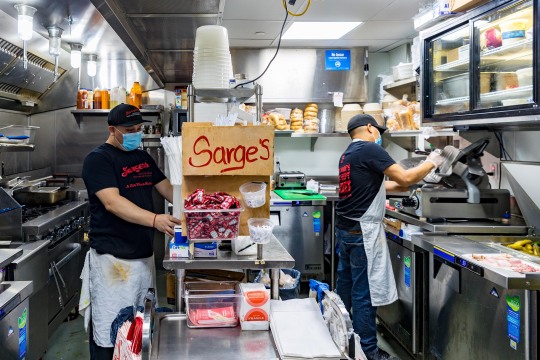
It is fair conclusion jumping to agree that the kitchens being accused of such chicanery are just being smart. They can try different price points, names, and a slew of other marketing variables, without having to actually create new products. And they are betting that most consumers will never notice. Just imagine, though, a Little Caesars—for example—also selling Bigga Pizza Pies, but they all come out of the same oven with the same crust, sauce, mozzarella, and toppings. Could you tell? And would you even care?
Uber Eats, et al., all want to make money, to be fair, but they do not want their service to be scammed like this. Getting two listings is little different form somehow managing to wrangle two display ads in a newspaper when you bought one, or any number of other of duplicative examples.
But wait, there’s more! Uber is also raising the bar on those it does list, requiring each establishment to have at least a 4.3 out of 5 rating on their app, have fewer than five-percent of orders canceled, and have fewer than five-percent delivery and order errors.
Thus far, Uber has removed more than 5000 entities it attests are simply clones of their parent, finding, in one instance, that a New York deli had 14 such clones under its umbrella. Can you imagine submitting 14 resumes for a job, each with a different name, but the person were the same? Shakespeare said a rose by any other name would smell as sweet, but that doesn’t work so well in job hunting or restaurant listings.
Uber says, though, it counts 40,000 virtual listings. Its internal police department is going to have its hands full enforcing its latest policy decision.
I know. You’ve probably already started thinking of a new hack in the wake of Uber clamping down. Why not simply give different names and/or plating variations so that the items are still pretty much the same, but look different on your screen? That would likely be easy. Imagine a meal of the Monster Burger and French Fries also being listed under a different brand as the Hamburger Monstre and pomme frites. Pretty much the same thing, but one sounds so cosmopolitan and worldly.
I’m pretty sure the ghost kitchens are already preparing their workarounds, because that’s the way we all roll. The spoils go to those who can hack the best. Meanwhile, just be careful placing your food orders. You might just be a victim as well. I can see that international burger fetching a higher price tag if only because it uses French words.
And I can imagine you looking like a ghost when you find out you’ve been duped, too.
Dr “Or You Could Just Cook At Home“ Gerlich
Audio Blog
3 notes
·
View notes
Text
What Are the Key Steps to Building a DoorDash Clone App?
Introduction
The popularity of apps like DoorDash has propelled the industry’s astonishing development in meal delivery. With these platforms, customers, restaurants, and delivery services can order and receive food in a simple manner.
They have become indispensable. A thorough grasp of both technical and business factors is necessary while developing a DoorDash clone software in order to…
0 notes
Text
A Step-by-Step Approach to Developing an UberEats Clone App: Tips and Best Practices

Developing an Uber Eats clone app can be a lucrative opportunity for entrepreneurs looking to enter the food delivery industry. With the growing demand for convenient food delivery services, creating a well-designed, user-friendly app can set you on the path to success. However, building a successful UberEats clone app requires careful planning, thoughtful design, and the integration of essential features. In this guide, we'll take you through a step-by-step approach to developing an UberEats clone app, offering tips and best practices to ensure your app meets user expectations and achieves business success.
Market Research and Planning
Understanding Your Target Audience
Before you begin developing your UberEats clone app, it's crucial to conduct thorough market research. Understanding your target audience's preferences, behaviors, and pain points will help you design an app that meets their needs. Consider factors such as demographics, location, and dining habits.
Analyzing Competitors
Study your competitors to identify what they do well and where they fall short. Analyze successful food delivery apps like Uber Eats, DoorDash, and Grubhub to understand their features, user experience, and pricing models. This analysis will guide you in creating a competitive app that stands out in the market.
Defining Your Unique Value Proposition
Your Uber Eats clone app should offer something unique that sets it apart from the competition. Whether it's faster delivery times, a broader selection of restaurants, or exclusive deals, defining your unique value proposition will attract users to your platform.
Choosing the Right Technology Stack
Front-End Development
The front end of your UberEats clone app is what users interact with, so it should be intuitive and visually appealing. Choose a technology stack that allows for responsive design and smooth performance across different devices. Common front-end technologies include React Native, Flutter, or Swift for iOS and Kotlin for Android.
Back-End Development
The back end is the engine that powers your app, handling tasks like order processing, user authentication, and payment processing. Opt for a robust back-end technology stack that ensures scalability and security. Popular choices include Node.js, Ruby on Rails, or Django.
Database Management
Your app will require a database to store user information, order details, and restaurant data. Choose a reliable and scalable database management system (DBMS) such as PostgreSQL, MySQL, or MongoDB.
Designing the User Interface (UI) and User Experience (UX)
User-Centered Design
The success of your UberEats clone app hinges on providing a seamless user experience. Design your app with the user in mind, ensuring that the interface is intuitive, easy to navigate, and visually appealing. Prioritize features that users value most, such as quick search, easy ordering, and real-time tracking.
Wireframing and Prototyping
Before diving into full-scale development, create wireframes and prototypes of your app. This step allows you to visualize the app's layout and functionality, making it easier to identify potential issues and make improvements early in the process.
Testing and Feedback
Conduct usability testing with real users to gather feedback on your app's design and functionality. This feedback will help you refine the user experience and address any pain points before launching the app.
Integrating Essential Features
Restaurant Listings and Menu Management
Your UberEats clone app should allow users to browse a wide selection of restaurants and view detailed menus. Implement features that enable restaurant owners to update their listings, manage menus, and showcase special offers.
Order Placement and Payment Processing
Simplify the order placement process by allowing users to customize their orders, select delivery options, and make payments securely. Integrate multiple payment gateways such as Stripe, PayPal, or Apple Pay to offer users flexibility in payment methods.
Real-Time Order Tracking
Real-time order tracking is a must-have feature for any food delivery app. Integrate GPS tracking to allow users to monitor the status of their orders from preparation to delivery. This feature enhances transparency and builds trust with your users.
Push Notifications
Push notifications are essential for keeping users informed about their orders, special offers, and promotions. Implement personalized notifications to engage users and encourage repeat orders.
Reviews and Ratings
Allow users to leave reviews and ratings for restaurants and delivery drivers. This feature builds credibility and helps other users make informed decisions when placing orders.
Customer Support
Provide a reliable customer support system within your app. Include features like in-app chat, FAQs, and support tickets to assist users with any issues they may encounter.
Testing and Quality Assurance
Functional Testing
Ensure that all features of your UberEats clone app work as intended by conducting thorough functional testing. Test each feature, from order placement to payment processing, to identify and fix any bugs.
Performance Testing
Evaluate the app's performance under different conditions, such as high traffic or low network connectivity. This testing ensures that your app can handle peak times without compromising user experience.
Security Testing
Security is paramount in any app that handles sensitive user data. Conduct security testing to identify vulnerabilities and implement measures to protect user information and payment details.
User Acceptance Testing (UAT)
Involve real users in the testing process by conducting user acceptance testing. This step helps ensure that the app meets user expectations and is ready for launch.
Launching and Marketing Your App
Launch Strategy
Plan a strategic launch for your UberEats clone app. Consider launching in phases, starting with a pilot launch in a specific region before expanding to other areas. This approach allows you to gather feedback and make improvements before scaling up.
Marketing and Promotion
Develop a comprehensive marketing strategy to promote your app and attract users. Utilize social media marketing, influencer partnerships, and digital advertising to increase visibility. Offering discounts or referral programs can also incentivize new users to try your app.
App Store Optimization (ASO)
Optimize your app's listing on app stores to increase its visibility and downloads. Use relevant keywords, compelling descriptions, and high-quality screenshots to attract potential users.
Continuous Improvement and Scaling
Gathering User Feedback
After launching your UberEats clone app, gather feedback from users to identify areas for improvement. Regularly update the app based on user suggestions to enhance the user experience.
Scaling Your App
As your user base grows, ensure that your app's infrastructure can handle increased traffic and demand. Consider adding new features, expanding to new regions, and partnering with more restaurants to scale your business.
Monitoring Performance
Continuously monitor your app's performance, including load times, crash reports, and user retention rates. Use analytics tools to gain insights into user behavior and optimize the app accordingly.
Conclusion
Developing an UberEats clone app with the help of an on-demand app development company involves careful planning, strategic execution, and ongoing refinement. By focusing on market research, technology selection, design, testing, and marketing, you can create a successful food delivery app that meets user needs and fosters business growth. Prioritizing user experience, integrating essential features, and staying responsive to feedback is key to building a reliable and competitive Uber Eats clone app in the crowded food delivery market.
#ubereats clone app#ubereats clone script#food delivery app#online food delivery app#readymade ubereats clone#on-demand food delivery#ubereats clone#white label ubereats clone#ubereats like app
0 notes
Text

How to Create an On-demand Food Delivery App – Step by Step
Guide Anticipating a staggering $96.5 billion in revenue by 2027, now is the perfect moment to launch your own cutting-edge app, such as a DoorDash rival or an on-demand app UberEats clone. Dive into the future of on-demand services here!
#fooddeliveryapp#fooddeliveryapplikeubereats#BuildanAppLikeUberEats#ubereatsapp#ondemandfooddeliveryapp#fooddeliveryappdevelopment
0 notes
Text
The advanced guide on building a Doordash Clone app 2022
To engage in DoorDash Clone Development, you should plan your application first. You can create a team of Developers, Designers, Content Creators, Marketers, and others to plan the Development and marketing strategy for the DoorDash Clone App.
DoorDash Clone Development isn't your singular goal. You should give time and provide updates for your App after its launch.
Customers use DoorDash Clone for Food Delivery. Therefore, your App needs to be up to date and cater to the customer's needs. You should hire a team that ensures customers don't face issues while working with the application.
When customers order any Food item through apps like DoorDash Clone, they become curious about their food's arrival. They wish to track their meal from the restaurant, delivery partners, and their homes.
You should add the Global Positioning System feature so customers can track their orders anytime. Moreover, this feature will ensure tracking of the food's journey.
The following employee type is Freelancers. It's challenging to find the ideal Freelancers for your company. You shall look for Freelancers with the necessary skill set and communication. Freelancers work per their will and time. Therefore, you have comparatively less control over Freelancer employees.
0 notes
Text
Features for DoorDash Clone Development
Instant Customer Support
What if a customer wants to order food for their upcoming party and faces issues while making the online payment?
What will they do? What if users face any other problem while using your DoorDash Clone?
Therefore, you should offer 24*7 customer care for your customers and DoorDash Clone App users. You can provide service through phone calls, e-mails, or chatbots.
For chatbots, BotPenguin is a perfect choice! You can integrate it with any website or application.
Multiple Payment Options
You shall add Multiple Payment Option criteria while performing DoorDash Clone Development.
Allow your customers to pay for the meals through credit cards, debit cards, and e-wallets, opt for cash-on-delivery, or select other payment methods per their requirements.
You don't want to lure your customers away and let them switch to another Food Delivery App due to a lack of payment methods.
Know more -
0 notes
Text
Top Benefits Of Developing An App Like DoorDash
Discover the top benefits of creating an app like DoorDash, including increased customer reach, streamlined operations, and enhanced brand visibility. To learn more, visit us at: https://richestsoft.com/doordash-clone-app-development
0 notes
Text
Top Tricks for Thriving with Your DoorDash Clone App

The DoorDash Clone App blog offers strategies to enhance the efficiency, usability, and profitability of your food delivery business. For more info visit here: https://shorturl.at/gBQZ3
0 notes
Text
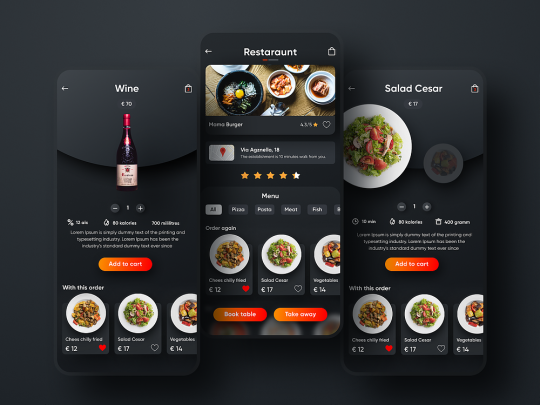


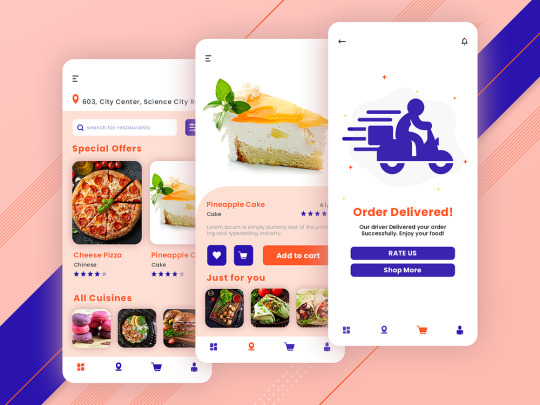
“From Idea to App: Developing a DoorDash and Zomato Clone with Omninos Technologies”
#Zomato clone,#Doordash clone,#Food Dellvery app
0 notes
Text
Is there a feature in the DoorDash clone script to handle special requests or dietary restrictions for orders?

Yes, our DoorDash clone script includes a section for customers to specify special requests or dietary restrictions while placing their orders. This information is then communicated to the restaurant, ensuring that the order is prepared according to the customer's preferences.
You can check more on https://noshway.com/doordash-clone-app-script/
#doordashcloneapp #doordashclonescript #doordashclone #doordashscript
0 notes
Text
Henceforth Solutions: Empowering Businesses with Clone App Solutions

At Henceforth Solutions, we are dedicated to empowering businesses with innovative clone app solutions that drive growth and success in the digital landscape. With our expertise in Doordash Clone, Talabat Clone, Dubizzle Clone, eBay Clone, Postmates Clone, Gojek Clone, Uber Clone, Airbnb Clone, Zomato Clone, Amazon Clone, Taskrabbit Clone, and more, we provide comprehensive app development services tailored to meet your specific business requirements.
Elevate Your Business with Custom Clone App Development
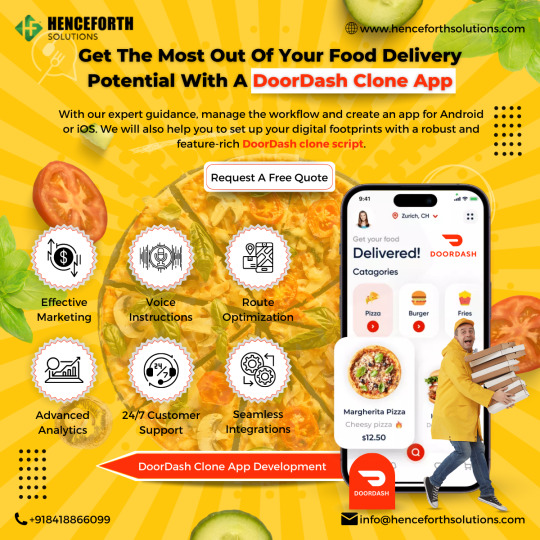
Doordash Clone: Revolutionize Food Delivery Services
Our Doordash Clone app development services offer a powerful solution to establish a robust food delivery platform. With advanced features like intuitive interfaces, real-time order tracking, secure payments, and customer ratings, our Doordash Clone app ensures a seamless experience for customers and delivery personnel alike. Explore the immense potential of the food delivery industry with our Doordash Clone app solution.
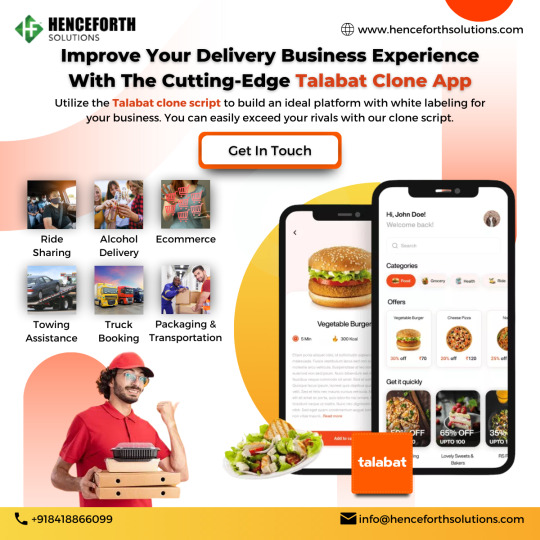
Talabat Clone: Build a Thriving Online Food Marketplace
With our Talabat Clone app development services, you can create a powerful online food marketplace that connects restaurants, customers, and delivery personnel seamlessly. From user-friendly interfaces and advanced search options to secure payments and restaurant reviews, our Talabat Clone app is designed to elevate your business in the food delivery sector. Harness the potential of a thriving online marketplace with our comprehensive Talabat Clone app solution.

Dubizzle Clone: Create a Dynamic Classified Ads Platform
Transform the classified ads industry with our Dubizzle Clone app development services. Our feature-rich Dubizzle Clone app provides an exceptional platform for buyers and sellers to connect effortlessly. With advanced search filters, secure transactions, review systems, and user-friendly interfaces, our Dubizzle Clone app enables you to establish a powerful presence in the online marketplace.

eBay Clone: Dominate the E-commerce Market
Experience the limitless potential of e-commerce with our eBay Clone app development services. Our comprehensive solution offers a robust platform for users to buy and sell products seamlessly. With advanced features such as bidding systems, secure payment gateways, personalized profiles, and advanced search algorithms, our eBay Clone app ensures a seamless online shopping experience that rivals industry giants.

Postmates Clone: Enter the On-Demand Delivery Industry
Our Postmates Clone app development services enable businesses to establish a reliable on-demand delivery platform. Seamlessly connecting customers, drivers, and merchants, our Postmates Clone app offers an intuitive interface, real-time tracking, secure payments, and order management systems. Explore the possibilities of entering the on-demand delivery industry with our feature-packed Postmates Clone app.

Gojek Clone: Unlock the Potential of Multi-Service Platforms
With our Gojek Clone app development services, you can create a versatile multi-service platform that offers ride-hailing, food delivery, grocery delivery, handyman services, and more. Our Gojek Clone app provides a user-friendly interface, efficient service management, secure payments, and real-time tracking. Embrace the power of a comprehensive on-demand service platform with our Gojek Clone app solution.
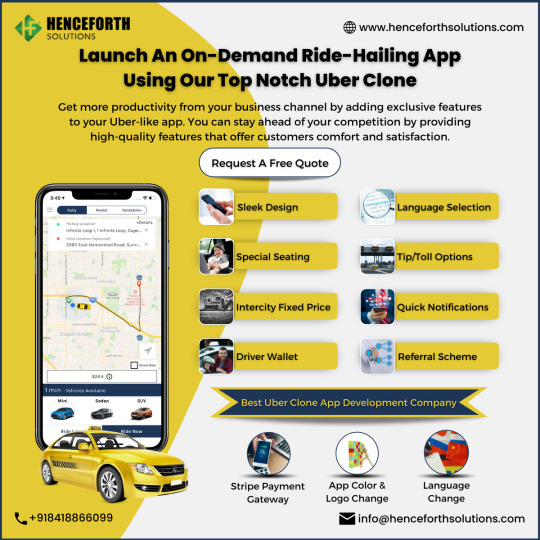
Uber Clone: Revolutionize Transportation Services
As a leading Uber Clone app development company, we specialize in crafting robust and feature-rich clone apps for the transportation industry. Our Uber Clone app offers seamless experiences for riders and drivers with features like real-time tracking, secure payments, ratings, and reviews. Experience the success of Uber in your transportation business with our reliable and innovative Uber Clone app solution.

Airbnb Clone: Thrive in the Vacation Rental Industry
With our Airbnb Clone app development services, you can establish a thriving vacation rental marketplace. Our Airbnb Clone app offers features like property listings, secure bookings, reviews, and more. Create a user-friendly platform that connects hosts and guests seamlessly, and elevate your business in the hospitality industry with our comprehensive Airbnb Clone app solution.
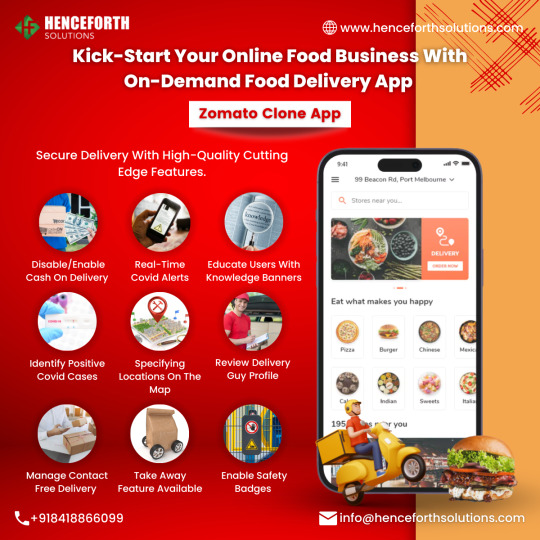
Zomato Clone: Dominate the Food Delivery Market
Our Zomato Clone app development services empower businesses to establish a powerful food delivery platform. With advanced search options, online payments, restaurant reviews, and intuitive interfaces, our Zomato Clone app ensures a seamless experience for customers, restaurants, and delivery personnel. Tap into the immense potential of the food delivery market with our comprehensive Zomato Clone app solution.

Amazon Clone: Build a Successful E-commerce Platform
Enter the world of e-commerce with our Amazon Clone app development services. Our comprehensive solution provides a feature-rich platform for users to buy and sell products effortlessly. With advanced search algorithms, secure payment systems, personalized profiles, and intuitive interfaces, our Amazon Clone app ensures a seamless online shopping experience that rivals industry giants.
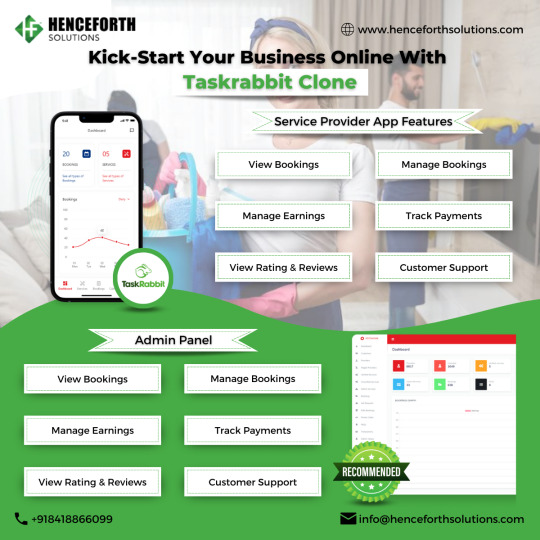
Taskrabbit Clone: Establish a Thriving On-Demand Service Marketplace
With our Taskrabbit Clone app development services, you can create a platform that connects customers with service providers seamlessly. From handyman services to personal assistance and more, our Taskrabbit Clone app offers a seamless experience for users seeking a variety of services. Enter the on-demand service industry with our reliable and feature-packed Taskrabbit Clone app solution.

Your Reliable Clone App Development Partner
At Henceforth Solutions, we go beyond just clone app development. We strive to understand your business requirements, industry dynamics, and target audience to deliver custom solutions that align with your goals. Our team of skilled developers, designers, and project managers work collaboratively to ensure that your clone app is built to perfection.
Whether you require a fully-customized clone app, specific modifications to an existing clone script, or comprehensive support and maintenance services, we have the expertise to meet your needs. Our commitment to excellence, attention to detail, and utilization of the latest technologies enable us to deliver outstanding results that empower your business to succeed.
#appdevelopment#mobile app development#blockchain#henceforth solutions#mobileappdevelopment#cryptocurrency#nft#crypto#nftart
1 note
·
View note